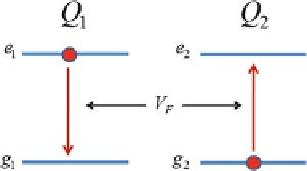Biomedical Engineering Reference
In-Depth Information
Fig. 10.1
Excitation energy transfer between molecular complexes
Q
1
and
Q
2
. A laser pulse
pumps the excited state
e
1
, upon de-excitation electrostatic energy is transferred to
Q
2
; absorption
on
Q
2
leads to the excited state
e
2
.
V
F
is the dipole-dipole Coulomb interaction responsible for
this process
In addition, let us suppose that molecule
Q
1
(donor) is initially on its electronic
excited state
e
1
after being pumped with an external laser pulse, whereas
Q
2
(ac-
ceptor) is on its ground state
g
2
. The Coulomb interaction among the two molecules
causes de-excitation of
Q
1
with electrostatic energy being transferred to
Q
2
causing
its respective excitation. This process is effectively equivalent to the recombination
of an exciton on site
Q
1
and its subsequent creation at site
Q
2
, or an exciton hopping
from
Q
1
to
Q
2
. This processes is known on the literature as FRET mechanism, based
on the early works of Forster and Dexter [
6
,
7
]. FRET is involved in a great variety
of physical chemistry phenomena, such as superradiance, long-range delocalization,
and exciton transport. The most fascinating manifestation of these phenomena
occurs in photosynthesis, which relies on the directed excitation transfer of the
energy collected by chromophores and photosynthetic light harvesting antennas [
8
].
10.3
FRET Coupling in QDMs
In a QDM the roles of the donor and acceptor complexes are played by individual
QDs [
9
-
11
]. Let's consider the two vertically and dissimilar disk-shaped QDs, QD1
and QD2, separated by a distance
|
R
|
, each having radius
|
r
1
|
and
|
r
2
|
, respectively,
see Fig.
10.2
.
The first step on deriving the interdot coupling leading to FRET is the calculation
of the interband transition dipole moments of exciton levels in each dot. This is
followed by the calculation of the Coulomb matrix element connecting exciton wave
functions at different dots. The Coulomb matrix element can be approximated by
a dipole-dipole interaction,
V
F
, following the standard procedure of Forster and
Dexter [
6
,
7
,
11
]. In the limit where the length-scale of exciton wave functions are
small in comparison with
|
R
|
, we can write,
πε
0
ε
r
R
3
e
2
3
(
r
1
·
R
)(
r
2
·
R
)
V
F
=
−
r
1
·
r
2
−
.
(10.1)
R
2
4


